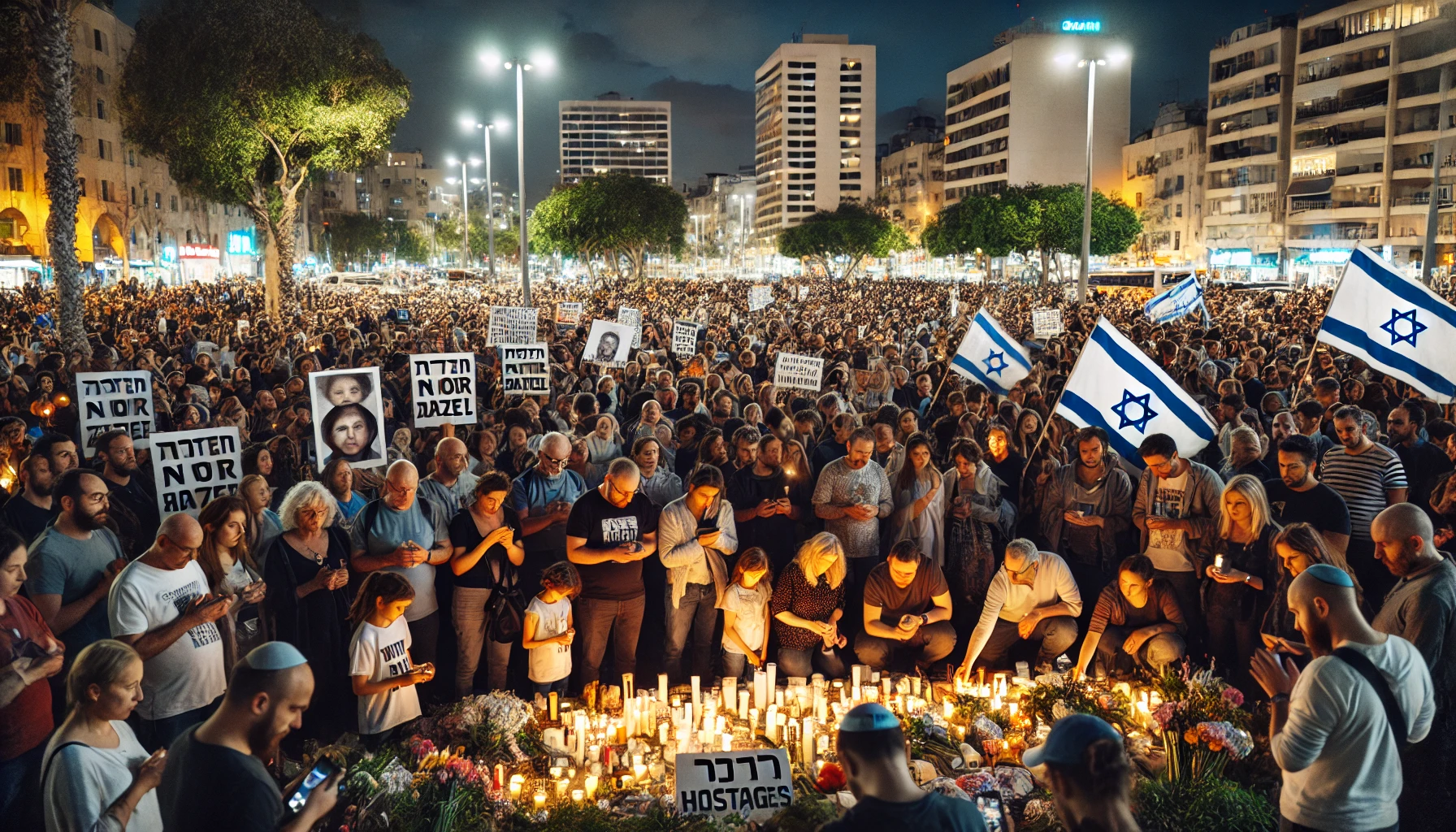For over a year, the Bibas family’s story has captured international attention. Shiri Bibas and her two sons, Kfir and Ariel, were among the more than 200 hostages taken by Hamas during the October 7, 2023, attack on Israel. Their images—especially the red-haired brothers—became symbols of the hostages still held in Gaza, with supporters around the world dressing in orange to remind people of their plight. The uncertainty surrounding their fate ended tragically when Hamas recently returned the bodies of the two children along with that of journalist and peace activist Oded Lifshitz. However, Israeli authorities soon discovered that the body Hamas claimed to be that of Shiri Bibas was actually someone else, raising new concerns and unanswered questions about what happened to her.
The Capture of the Bibas Family
On October 7, 2023, Hamas launched an attack on Israel, killing approximately 1,200 people and taking more than 200 hostages. Among them was the Bibas family, who lived in Kibbutz Nir Oz. A widely shared video showed Shiri, 32, clutching her two young sons—nine-month-old Kfir and four-year-old Ariel—as they were forcibly taken by Hamas militants. Their father, Yarden Bibas, was captured separately and taken to another location in Gaza.
For months, their family, friends, and supporters anxiously waited for news, hoping they would be included in a hostage release deal. When a temporary ceasefire agreement in November 2023 led to the release of 100 hostages, many expected that Shiri and her children would be among them. However, they were not freed. Hamas later claimed that the Bibas family had been killed in an Israeli airstrike, though they provided no evidence.
The Return of the Bodies
On February 20, 2025, after 16 months of uncertainty, Hamas handed over four bodies to Israel, saying they belonged to Shiri Bibas, her sons, and Oded Lifshitz. The handover quickly became a public spectacle, with Hamas militants displaying the coffins on a stage in Gaza. A large image of Israeli Prime Minister Benjamin Netanyahu, edited to depict him as a vampire, was hung above them. A sign near the coffins read, “The Return of the War = The Return of Your Prisoners in Coffins,” which many saw as a threat aimed at Israel. The event drew strong condemnation from the United Nations, which said it violated international laws that require respectful treatment of the deceased and their families.
When the bodies arrived in Israel, large crowds lined the streets to pay their respects. Many waved Israeli flags, while others wept at Hostages Square in Tel Aviv. The remains were taken to Israel’s National Center of Forensic Medicine, where forensic experts conducted detailed examinations. The results revealed a shocking discovery: while the bodies of Kfir and Ariel Bibas were confirmed, the body that Hamas claimed was Shiri Bibas was actually that of a different woman, believed to be a Palestinian civilian.
Conflicting Claims and the Search for Shiri
The revelation that Shiri Bibas’s body was not among those returned outraged Israeli officials. The Israel Defense Forces (IDF) accused Hamas of violating the ceasefire agreement by failing to return her remains. Hamas, in response, stated that it would investigate the situation and insisted that it was committed to upholding the ceasefire agreement. The group suggested that Shiri’s body may have been lost in the rubble after an Israeli airstrike and may have been mistakenly buried alongside Palestinian civilians.

Israeli authorities have not accepted Hamas’s explanation. They have demanded the immediate return of Shiri Bibas, along with all remaining hostages, whether they are alive or deceased. Prime Minister Benjamin Netanyahu called Hamas’s actions “an unimaginable cynical move” and vowed that Israel would ensure that Hamas faced consequences. The IDF also emphasized that Hamas was responsible for keeping track of hostages and was obligated to return them properly.
How Did the Bibas Boys Die?
The forensic examination of Kfir and Ariel Bibas confirmed that they had been murdered while in captivity. The IDF stated that based on intelligence and forensic evidence, the two boys had been killed by Hamas militants in November 2023, just a month after their capture. However, Hamas continues to claim that the family died in an Israeli airstrike. The exact circumstances of their deaths remain unclear, as neither Hamas nor Israeli authorities have provided detailed proof of their respective claims.
The deaths of Kfir and Ariel have devastated many in Israel. At just nine months old, Kfir was the youngest hostage taken during the attack and the youngest to be killed. His older brother, Ariel, had just turned four. Their bright red hair and innocent smiles made them recognizable figures in the international campaign to bring hostages home. Their tragic fate has left many grieving, while the absence of their mother’s body has only added to the pain.
The Impact on the Ceasefire and Future Hostage Releases
Despite the controversy over the return of the Bibas family’s remains, the ceasefire between Israel and Hamas has not yet been broken. Another hostage exchange is scheduled soon, with six living Israeli hostages expected to be released. However, the situation remains fragile. Many Israeli leaders are now calling for renewed military action against Hamas, arguing that the ceasefire is not being honored. Others, including families of remaining hostages, believe that negotiations should continue in order to bring more captives home safely.
Among those pushing for continued negotiations is the leadership of Kibbutz Nir Oz, the Bibas family’s hometown. They released a statement urging Israel to focus on securing the return of all hostages, rather than seeking revenge. “The state must bring Shiri back by all means, in a way that does not jeopardize the continuation of the deal and the immediate release of all the hostages,” they said.
Israeli officials and the families of the hostages continue to demand that Hamas return all remaining captives, dead or alive. The United Nations and other international organizations have also called on Hamas to honor its commitments and provide full transparency about the status of all hostages.
This article is based on the following articles:

Background Information
1. The Israel-Palestine Conflict and Hamas
The ongoing conflict between Israel and Palestine has lasted for many decades. It is centered around disputes over land, history, and political control. One of the key groups involved in the conflict is Hamas, a Palestinian militant group that controls Gaza, a small but densely populated area near Israel. Hamas was founded in the late 1980s and has been in power in Gaza since 2007. Many countries, including the United States and Israel, consider Hamas a terrorist organization, while others see it as a resistance movement against Israeli control.
Hamas has fought multiple wars against Israel, launching rockets and carrying out attacks, while Israel has responded with airstrikes and military operations. These conflicts have caused thousands of deaths, including many civilians on both sides. One of the most recent and deadliest attacks happened on October 7, 2023, when Hamas launched a surprise assault on Israel, killing about 1,200 people and taking more than 200 hostages, including the Bibas family.
2. What Are Hostages and Why Are They Taken?
A hostage is a person who is captured and held by a group, usually as a way to demand something in return. Hostages are often taken during wars, conflicts, or criminal situations. Groups that take hostages usually do so to gain political power, force negotiations, or pressure governments into making certain decisions.
During the October 7, 2023, Hamas attack, over 200 people were kidnapped from Israel and taken into Gaza. Some were civilians, meaning they were not involved in the fighting, while others were soldiers. Among them were the Bibas family, including baby Kfir, who became the youngest hostage taken in the conflict.
Hostages are often used in prisoner exchanges, where one side agrees to release hostages in return for the release of prisoners from the other side. Some hostages were freed in November 2023 during a temporary ceasefire, but many others remained in captivity.
3. The Rules of War and Treatment of Hostages
There are international laws that govern how people should be treated during war. One of the most important sets of rules is the Geneva Conventions, which are agreements that many countries have signed to protect civilians, prisoners of war, and hostages.
Under these rules:
- Hostages should not be harmed and must be treated humanely.
- Dead bodies must be treated with respect, and families should be given accurate information about their loved ones.
- Torture and cruelty against prisoners or hostages are considered war crimes.
The way Hamas displayed the Bibas family’s coffins in Gaza, using them for propaganda, was seen by many as a violation of international law. The United Nations (UN) condemned Hamas for its actions, calling them inhumane and degrading.
4. How Are Bodies Identified After Conflicts?
When bodies are found after a conflict, forensic experts use different scientific methods to confirm their identities. This process is important because families need to know what happened to their loved ones, and governments need evidence before making official statements.
Some common methods used to identify bodies include:
- DNA Testing – Scientists compare the DNA from a body with samples from the person’s relatives.
- Dental Records – If a person’s dental history is available, experts can compare it to the teeth of the body found.
- X-rays and Medical Records – Past injuries, surgeries, or bone structures can help confirm someone’s identity.
In the case of the Bibas family, forensic scientists in Israel used DNA tests, dental records, and X-ray comparisons to confirm that the two children, Kfir and Ariel, had been killed. However, when they examined the body that Hamas claimed was Shiri Bibas, they found that it belonged to a different woman. This discovery led to further tensions between Israel and Hamas.
5. The Role of the Red Cross in War
The International Committee of the Red Cross (ICRC) is an organization that helps victims of war, provides medical care, and ensures that the rules of war are followed. One of its important roles is acting as a neutral party in hostage exchanges.
In this case, the Red Cross helped oversee the transfer of the Bibas family’s remains from Hamas to Israel. During the handover, Red Cross workers tried to shield the coffins from the public, but the event still became a spectacle.
6. Why Ceasefires Are Important and Fragile
A ceasefire is a temporary pause in fighting, usually to allow for peace talks, humanitarian aid, or hostage exchanges. However, ceasefires can be fragile and easily broken if either side feels that the other is not following the agreement.
The discovery that Hamas did not return the body of Shiri Bibas has increased tensions between Israel and Hamas. Some Israeli leaders believe that this violation means the ceasefire should end and that military action should resume, while others argue that negotiations should continue to bring more hostages home.
7. The Emotional Impact of the Bibas Family’s Story
The Bibas family’s story has affected people all over the world. Their faces have been seen in cities worldwide on billboards, posters, and protests, reminding people of the suffering caused by the conflict.
Kfir’s image, showing him smiling with his pink elephant toy, became a heartbreaking symbol of the innocent lives caught in war. Ariel, who loved Batman, was also widely recognized. These photos appeared in places such as Times Square in New York, the World Economic Forum in Switzerland, and rallies in London, Berlin, and Paris.The uncertainty surrounding Shiri’s fate adds to the pain felt by their family and supporters. People around the world continue to follow the case, hoping for answers and justice.

Debate/Essay Questions
- Should Israel continue to negotiate for the return of hostages, or should it take military action to retrieve them?
Please subscribe to Insight Fortnight, our biweekly newsletter!
